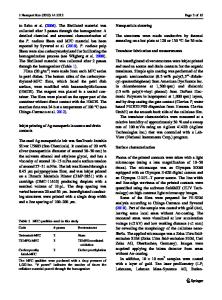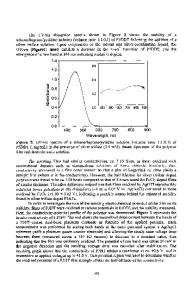Highly Flexible, Transparent and Electrically Conducting Silver Nanoparticles Films Enabled by Controlled Sedimentation
- PDF / 670,851 Bytes
- 5 Pages / 612 x 792 pts (letter) Page_size
- 88 Downloads / 292 Views
Highly Flexible, Transparent and Electrically Conducting Silver Nanoparticles Films Enabled by Controlled Sedimentation Matthew Ombaba, 1Takayuki Hasegawa1,2 Li Lu,1,3 Yusuke Yasuda1,3 Mutsumi Kimura,2 Takashi Nishida,3 Shinji Koh,3 Yukihara Uraoka,3 and *M. Saif Islam3 1
University of California, Electrical and Computer Engineering, One shields Avenue, Davis, California, U.S.A, 95616. 2 Ryukoku University, Department of Electronics and Informatics, Seta, Otsu, 520-2194, Japan. 3 Nara Institute of Science and Technology (NAIST), Graduate School of Materials Science, 8916-5 Takayama, Ikoma, Nara, 630-0192, Japan. *Corresponding Author. ABSTRACT Often, silver nanoparticles (AgNps) are looked at in the realm of their plasmonic effects that are characterized by unique absorptional bands in the visible spectrum. Herein, the kinetics of a simple gravity mediated sedimentation process of AgNps, in aqueous suspensions. The surface energy mismatch between the AgNps and the receiver substrate allow for the formation of irregularly shaped AgNp microclusters with interconnected microchannels with dimensions and particle density controlled by the distance between the exposed substrate surface and the water/suspension interface. An investigation of the interplay between these properties and the films’ nanoparticle density is presented.
INTRODUCTION Nanoparticle (Np) immobilization techniques like self-assembly via Langmuir Blodgettry1, layer by layer approaches2, surface tension mediated routes3, as well as spin coating of specifically functionalized Nps with a surface energy controlling ligands at specific speeds have been used to prepare AgNp films time and again These techniques suffer from scalability challenges. Further, characteristics of statistically distributed or immobilized, submicron and micron sized AgNp films have been obtained from their composites with cross-linked4, uncross-linked polymeric matrices5 and inorganic glasses6. However, these do not present true characteristics of pristine AgNp films due to the propensity of the matrices to influence the resultant optical, thermal and electrical properties of the composites under study. It is therefore pertinent to develop simple models and experimental setups to obtain and evaluate characteristics of submicron sized AgNp films not only from the commercial view point, but also in the realm of fundamental understanding of such assemblies. A good example has been recently, demonstrated by Yang et al, who studied gravity facilitated sedimentation of polyhedral AgNps into plasmonic crystals 7. Although long range ordering of the Nps that resulted in relatively large area films whose packing was dictated by gravity was reported, only plasmonic properties of these assemblies were looked into
Herein, we look at the kinetics of gravity assembled soft submicron sized AgNps onto flexible substrates from their aqueous colloidal suspensions, yielding semi or thin AgNps films over large areas. We report, a fundamental characteristics of these films and herald this as a simple
Data Loading...











